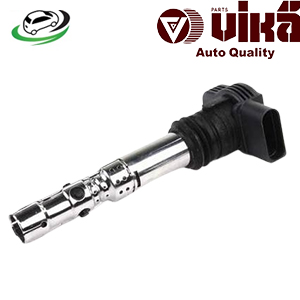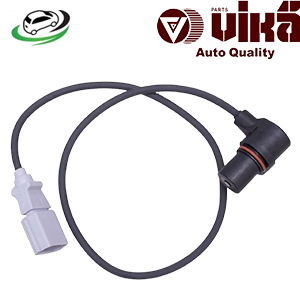-15%
Get AUDI B5 A4/ B5 S4/ B6 A4/ C5 A6/ TT MKI/ C5 Allroad / VW Golf IV/ Jetta IV/ New Beetle/ Passat B5 Crankshaft Position Sensor 06A906433C
The crankshaft position sensor (CKP sensor) is a critical component in modern internal combustion engines, playing a vital role in engine management and operation. It monitors the position and rotational speed of the crankshaft, providing essential data to the engine control unit (ECU) for optimizing performance, fuel efficiency, and emissions. This detailed explanation covers the purpose, types, operation, benefits, common issues, and maintenance of crankshaft position sensors.
What is a Crankshaft Position Sensor?
The crankshaft position sensor is an electronic device that monitors the position and rotational speed of the crankshaft in an engine. This sensor helps the ECU determine the timing of fuel injection and ignition, ensuring that the engine operates efficiently and effectively. Without accurate data from the crankshaft position sensor, the engine would struggle to maintain optimal performance and could experience issues such as misfires, rough idling, and reduced power output.
How Does a Crankshaft Position Sensor Work?
The crankshaft position sensor operates by detecting the position of the crankshaft as it rotates within the engine. There are two main types of crankshaft position sensors: inductive (or magnetic) sensors and Hall effect sensors. Both types work on different principles but serve the same function.
- Inductive Sensors
Inductive crankshaft position sensors use electromagnetic induction to generate a voltage signal. These sensors typically consist of a coil of wire wrapped around a core and a magnetic pickup. As the crankshaft rotates, a reluctor wheel (also known as a tone wheel) with notches or teeth passes near the sensor. The movement of the notches creates a changing magnetic field, which induces a voltage in the coil. This voltage signal is then sent to the ECU, which interprets the information to determine the crankshaft’s position and speed. - Hall Effect Sensors
Hall effect crankshaft position sensors operate based on the Hall effect principle, which states that a voltage is generated when a magnetic field is applied to a conductive material. These sensors typically consist of a semiconductor material that detects the presence of a magnetic field. When the crankshaft rotates, a magnet attached to the crankshaft passes by the sensor. This movement generates a voltage signal that the ECU can read to determine the crankshaft’s position and rotational speed.
Both types of sensors provide the ECU with crucial data, including the exact position of the crankshaft in relation to the engine’s cylinders and the speed at which the crankshaft is rotating.
Functions of a Crankshaft Position Sensor
- Engine Timing Control
One of the primary functions of the crankshaft position sensor is to provide the ECU with accurate data for timing the fuel injection and ignition systems. By knowing the exact position and speed of the crankshaft, the ECU can optimize the timing of fuel delivery and ignition, resulting in efficient combustion and improved engine performance. - Misfire Detection
The crankshaft position sensor helps detect misfires in the engine. If the ECU senses a deviation in the expected crankshaft speed or position, it can trigger a misfire code, alerting the driver to potential issues within the ignition or fuel systems. - Engine Speed Measurement
The sensor provides real-time data on the engine’s speed (RPM). This information is critical for the ECU to adjust various parameters, including fuel mixture, ignition timing, and throttle position, ensuring the engine operates smoothly across different driving conditions. - Synchronization with Camshaft Position Sensor
In modern engines, the crankshaft position sensor works in conjunction with the camshaft position sensor (CMP sensor) to provide comprehensive data about the engine’s timing. This synchronization is essential for variable valve timing (VVT) systems, which optimize engine performance by adjusting the timing of the intake and exhaust valves.
Benefits of a Well-Functioning Crankshaft Position Sensor
- Enhanced Engine Performance
A properly functioning crankshaft position sensor ensures that the ECU receives accurate information for timing fuel injection and ignition. This leads to smoother acceleration, improved throttle response, and better overall engine performance. - Fuel Efficiency
With optimized timing, the engine can achieve better fuel combustion, leading to improved fuel efficiency. A malfunctioning sensor can cause the engine to run rich or lean, wasting fuel and increasing emissions. - Reduced Emissions
Accurate data from the crankshaft position sensor helps maintain optimal combustion, reducing harmful emissions. This is especially important for meeting regulatory standards and improving the vehicle’s environmental footprint. - Prevention of Engine Damage
The crankshaft position sensor plays a role in detecting misfires and other potential issues in the engine. By alerting the ECU to these problems, the sensor helps prevent severe engine damage and costly repairs.
Common Symptoms of a Faulty Crankshaft Position Sensor
- Engine Misfires
A failing crankshaft position sensor can cause engine misfires due to incorrect timing of fuel injection and ignition. Drivers may experience a rough idle, hesitation during acceleration, or a loss of power while driving. - Difficulty Starting the Engine
If the sensor is malfunctioning, the ECU may not receive the correct signals needed to start the engine. This can lead to hard starting or an engine that won’t start at all. - Check Engine Light
A faulty crankshaft position sensor can trigger the Check Engine Light on the dashboard. Diagnostic trouble codes (DTCs) related to the sensor may be stored in the ECU, which can be read using an OBD-II scanner. - Poor Fuel Economy
Inaccurate data from the crankshaft position sensor can lead to inefficient fuel combustion, resulting in reduced fuel economy. Drivers may notice that they are refueling more frequently than usual. - Loss of Power
A malfunctioning crankshaft position sensor may cause the engine to lose power, especially during acceleration. This occurs because the ECU is unable to deliver the correct timing for fuel injection and ignition. - Engine Stalling
In some cases, a faulty sensor can cause the engine to stall while driving. This can be dangerous, as it may happen unexpectedly and without warning.
Maintenance and Replacement Tips for Crankshaft Position Sensors
- Regular Inspections
Routine inspections of the crankshaft position sensor can help detect potential issues early. Look for visible signs of damage, such as frayed wires, cracked housings, or corrosion at the connector. - Check Engine Codes
If the Check Engine Light comes on, use an OBD-II scanner to read the trouble codes. If codes related to the crankshaft position sensor (such as P0335, P0336, etc.) are present, further investigation may be necessary. - Replace When Necessary
If the crankshaft position sensor is found to be faulty or showing signs of wear, it should be replaced as soon as possible. Delaying replacement can lead to more severe engine performance issues and potential damage. - Use Quality Replacement Parts
When replacing the crankshaft position sensor, it’s essential to use high-quality OEM (original equipment manufacturer) or reputable aftermarket parts. Low-quality sensors may not provide accurate data and could fail prematurely. - Check Wiring and Connectors
Inspect the wiring and connectors leading to the crankshaft position sensor for any signs of damage, wear, or corrosion. Damaged wires or poor connections can cause the sensor to malfunction, leading to inaccurate readings. - Monitor Engine Performance
Pay attention to any changes in engine performance, fuel economy, or warning lights. If any issues arise, have the vehicle checked to identify whether the crankshaft position sensor is functioning correctly.
Conclusion
The crankshaft position sensor is a vital component of an engine’s management system, providing essential data for timing fuel injection and ignition. Its accurate functioning is crucial for maintaining optimal engine performance, fuel efficiency, and emissions control. Regular maintenance, timely replacement, and proper inspection of the crankshaft position sensor can help ensure the smooth operation of the engine and prevent costly repairs in the long run. Understanding the function and importance of this sensor can aid vehicle owners in making informed decisions about maintenance and repairs, ultimately leading to a more reliable and efficient vehicle.
Follow us on Facebook for more parts.






Reviews
Clear filtersThere are no reviews yet.